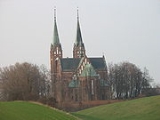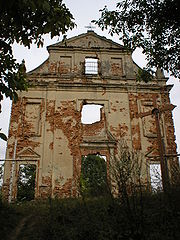
Garbów
Encyclopedia
Garbów ' is a village
in Lublin County
, Lublin Voivodeship
, in eastern Poland. It is the seat of the gmina
(administrative district) called Gmina Garbów
. It lies approximately 20 km (12 mi) north-west of the regional capital Lublin
. The village has a population of approximately 2,000. It lies on the Kurówka river, and has a mill and a sugar refinery.

 The village was first mentioned in 1326 as a seat of a separate parish
The village was first mentioned in 1326 as a seat of a separate parish
. In 15th century it was a personal property of the Odrowąż clan. In 1785 it was sold to Jacek Jezierski
, the castellan of Łuków and a marshall of the szlachta
who made the village receive the Magdeburg Law. During the Kościuszko Uprising
of 1794 the town was a battlefield of the last skirmish between the forces of Muscovy and those of Poland. After that the town was annexed by Russia and its city status was withdrawn. Currently the village is formally divided onto two separate sołectwos: Garbów I and Garbów II. It is probable, that the two will be eventually merge and receive city charter again.
There are some notable tourist attractions in the village. Among them is an 18th century classicist palace, a facade of a 17th century church destroyed in 1915 and a Gothic revival church from early 20th century with a 1000 kilograms bell from 1512.
Village
A village is a clustered human settlement or community, larger than a hamlet with the population ranging from a few hundred to a few thousand , Though often located in rural areas, the term urban village is also applied to certain urban neighbourhoods, such as the West Village in Manhattan, New...
in Lublin County
Lublin County
Lublin County is a unit of territorial administration and local government in Lublin Voivodeship, eastern Poland. It came into being on January 1, 1999, as a result of the Polish local government reforms passed in 1998. Its administrative seat is the city of Lublin, although the city is not part...
, Lublin Voivodeship
Lublin Voivodeship
- Administrative division :Lublin Voivodeship is divided into 24 counties : 4 city counties and 20 land counties. These are further divided into 213 gminas....
, in eastern Poland. It is the seat of the gmina
Gmina
The gmina is the principal unit of administrative division of Poland at its lowest uniform level. It is often translated as "commune" or "municipality." As of 2010 there were 2,479 gminas throughout the country...
(administrative district) called Gmina Garbów
Gmina Garbów
Gmina Garbów is a rural gmina in Lublin County, Lublin Voivodeship, in eastern Poland. Its seat is the village of Garbów, which lies approximately north-west of the regional capital Lublin....
. It lies approximately 20 km (12 mi) north-west of the regional capital Lublin
Lublin
Lublin is the ninth largest city in Poland. It is the capital of Lublin Voivodeship with a population of 350,392 . Lublin is also the largest Polish city east of the Vistula river...
. The village has a population of approximately 2,000. It lies on the Kurówka river, and has a mill and a sugar refinery.


Parish
A parish is a territorial unit historically under the pastoral care and clerical jurisdiction of one parish priest, who might be assisted in his pastoral duties by a curate or curates - also priests but not the parish priest - from a more or less central parish church with its associated organization...
. In 15th century it was a personal property of the Odrowąż clan. In 1785 it was sold to Jacek Jezierski
Jacek Jezierski
Jacek Jezierski was a Polish writer and businessman, a member of the Polish nobility and a political writer. From 1775 he was the castellan of the town of Łuków. He was also manager of the personal domain of the Primate of Poland, which allowed him to gain a significant fortune...
, the castellan of Łuków and a marshall of the szlachta
Szlachta
The szlachta was a legally privileged noble class with origins in the Kingdom of Poland. It gained considerable institutional privileges during the 1333-1370 reign of Casimir the Great. In 1413, following a series of tentative personal unions between the Grand Duchy of Lithuania and the Kingdom of...
who made the village receive the Magdeburg Law. During the Kościuszko Uprising
Kosciuszko Uprising
The Kościuszko Uprising was an uprising against Imperial Russia and the Kingdom of Prussia led by Tadeusz Kościuszko in Poland, Belarus and Lithuania in 1794...
of 1794 the town was a battlefield of the last skirmish between the forces of Muscovy and those of Poland. After that the town was annexed by Russia and its city status was withdrawn. Currently the village is formally divided onto two separate sołectwos: Garbów I and Garbów II. It is probable, that the two will be eventually merge and receive city charter again.
There are some notable tourist attractions in the village. Among them is an 18th century classicist palace, a facade of a 17th century church destroyed in 1915 and a Gothic revival church from early 20th century with a 1000 kilograms bell from 1512.

